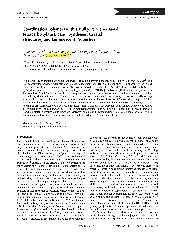摘要
To explore the coordination possibilities of perylene-based ligands with a larger conjugated pi-system, four Zn(II), Mn(II), and Co(II) coordination polymers with perylene-3,4,9,10-tetracarboxylate (ptc) and the chelating 1,10-phenanthroline (phen) ligands were synthesized and characterized: {[Zn(2)(ptc)(phen)(2)](H(2)O)(10)}(infinity) (1), {[Zn(3)(ptc)(OH)(2)(phen)(2)](H(2)O)(3)}(infinity) (2), {[Mn(ptc)(0.5)(phen)(H(2)O)(2)](H(2)O)(1.5)}(infinity) (3), and {[Co(ptc)(0.5)(phen)(H(2)O)(2)](H(2)O)(2.5)}(infinity) (4). Structural analysis reveals that complexes 1 and 2 both take one-dimensional polymeric chain structures with dinuclear and trinuclear units as nodes, respectively, which are further extended via the accessorial secondary interchain interactions, such as C-H center dot center dot center dot O H-bonding or aromatic pi center dot center dot center dot pi stacking interactions, to give rise to the relevant higher-dimensional frameworks. Compound 3 has a two-dimensional sheet structure that is further assembled to form a three-dimensional framework by interlayer pi center dot center dot center dot pi stacking interactions. Complex 4 is a one-dimensional ribbon-like array structure that is interlinked by the co-effects of intermolecular pi center dot center dot center dot pi stacking and C-H center dot center dot center dot pi supramolecular interactions, resulting in a higher-dimensional framework from the different crystallographic directions. Moreover, complexes 1-4 exhibit strong solid-state luminescence emissions at room temperature, which mainly originate from intraligand pi -> pi* transitions of ptc.
- 出版日期2010
- 单位郑州轻工业大学
